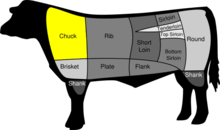Chuck steak
 Different U.S. cuts of beef | |
| Type | cut of beef |
|---|---|
Chuck steak is a cut of beef and is part of the sub primal cut known as the chuck.[1]
The typical chuck steak is a rectangular cut, about 1" thick and containing parts of the shoulder bones, and is often known as a "7-bone steak," as the shape of the shoulder bone in cross section resembles the numeral '7'. This cut is usually grilled or broiled; a thicker version is sold as a "7-bone roast" or "chuck roast" and is usually cooked with liquid as a pot roast.
The bone-in chuck steak or roast is one of the more economical cuts of beef. In the United Kingdom, this part is commonly referred to as "braising steak". It is particularly popular for use as ground beef, due to its richness of flavor and balance of meat and fat.
Variations
Other boneless chuck cuts include the chuck eye (boneless cuts from the center of the roll, sold as mock tender steak or chuck tender steak), chuck fillet (sold as chuck eye steak and chuck tender steak,) cross-rib roast (sold as cross-rib pot roast, English roast, or "the bread and butter cut"), top blade steak or chicken steak, under blade steak, shoulder steak and shoulder roast, and arm steak and arm roast.
The average meat market cuts thick and thin chuck steaks (often sold as chuck steak or chuck steak family pack) from the neck and shoulder, but some markets also cut it from the center of the cross-rib portion. Short ribs are cut from the lip of the roll.
Some meat markets will sell cross-rib pot roast under the generic name "pot roast." The difference between a pot roast and a cross-rib pot roast is the vertical line of fat separating the two types of chuck meat; the cross-rib pot roast contains the line of fat. This is what creates richness of flavor in the roast.
Common uses
The chuck contains a lot of connective tissue, including collagen, which partially melts during cooking. Meat from the chuck is usually used for stewing, slow cooking, braising, or pot roasting.
Classification
In the United States, chuck has the meat-cutting classification NAMP 113.
See also
Notes
Sources
- Green, Aliza (2005). Field Guide to Meat. Philadelphia, PA: Quirk Books. ISBN 1-59474-017-8.

